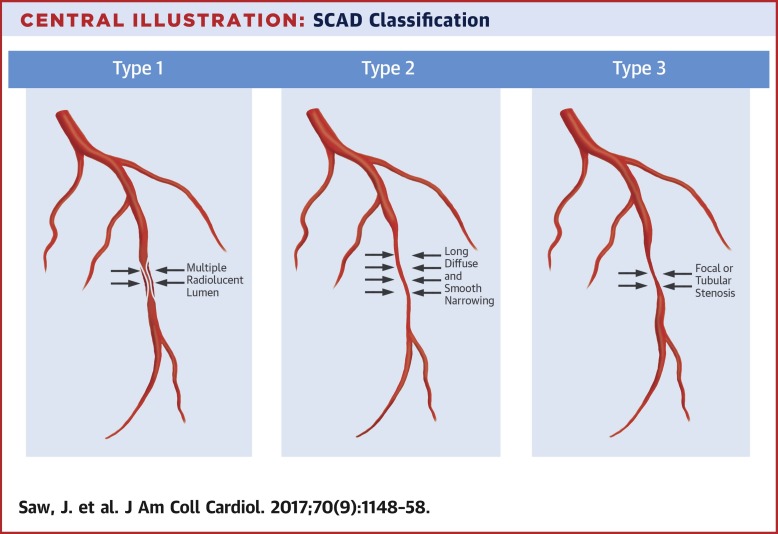当前位置:
X-MOL 学术
›
J. Am. Coll. Cardiol.
›
论文详情
Our official English website, www.x-mol.net, welcomes your
feedback! (Note: you will need to create a separate account there.)
Spontaneous Coronary Artery Dissection
Journal of the American College of Cardiology ( IF 21.7 ) Pub Date : 2017-08-01 , DOI: 10.1016/j.jacc.2017.06.053 Jacqueline Saw , Karin Humphries , Eve Aymong , Tara Sedlak , Roshan Prakash , Andrew Starovoytov , G.B. John Mancini
Journal of the American College of Cardiology ( IF 21.7 ) Pub Date : 2017-08-01 , DOI: 10.1016/j.jacc.2017.06.053 Jacqueline Saw , Karin Humphries , Eve Aymong , Tara Sedlak , Roshan Prakash , Andrew Starovoytov , G.B. John Mancini

|
BACKGROUND
Spontaneous coronary artery dissection (SCAD) is underdiagnosed and an important cause of myocardial infarction (MI), especially in young women. Long-term cardiovascular outcomes, including recurrent SCAD, are inadequately reported. OBJECTIVES
This study sought to describe the acute and long-term cardiovascular outcomes and assess the predictors of recurrent SCAD. METHODS
Nonatherosclerotic SCAD patients were prospectively followed at Vancouver General Hospital systematically to ascertain baseline, predisposing and precipitating stressors, angiographic features, revascularization, use of medication, and in-hospital and long-term cardiovascular events. Clinical predictors for recurrent de novo SCAD were tested using univariate and multivariate Cox regression models. RESULTS
The authors prospectively followed 327 SCAD patients. Average age was 52.5 ± 9.6 years, and 90.5% were women (56.9% postmenopausal). All presented with MI; 25.7% had ST-segment elevation MI, 74.3% had non-ST-segment elevation MI, and 8.9% had ventricular tachycardia/ventricular fibrillation. Precipitating emotional stressors were reported in 48.3% and physical stressors in 28.1%. Fibromuscular dysplasia was present in 62.7%, connective tissue disorder in 4.9%, and systemic inflammatory disease in 11.9%. The majority (83.1%) were initially treated medically, with only 16.5% or 2.2% undergoing in-hospital percutaneous coronary intervention or coronary artery bypass graft surgery, respectively. The majority of SCAD patients were taking aspirin and beta-blocker therapy at discharge and at follow-up. Median hospital stay was 3.0 days, and the overall major adverse event rate was 7.3%. Median long-term follow-up was 3.1 years, and overall major adverse cardiac event rate was 19.9% (death rate: 1.2%; recurrent MI: 16.8%; stroke/transient ischemic attack: 1.2%; revascularization: 5.8%). Recurrent SCAD occurred in 10.4% of patients. In multivariate modeling, only hypertension increased (hazard ratio: 2.46; p = 0.011) and beta-blocker use diminished (hazard ratio: 0.36; p = 0.004) recurrent SCAD. CONCLUSIONS
In our large prospectively followed SCAD cohort, long-term cardiovascular events were common. Hypertension increased the risk of recurrent SCAD, whereas beta-blocker therapy appeared to be protective.
中文翻译:

自发性冠状动脉夹层
背景自发性冠状动脉夹层 (SCAD) 诊断不足,是心肌梗塞 (MI) 的重要原因,尤其是在年轻女性中。长期心血管结果,包括复发性 SCAD,报告不充分。目的 本研究旨在描述急性和长期心血管结局并评估 SCAD 复发的预测因素。方法 在温哥华总医院对非动脉粥样硬化 SCAD 患者进行系统的前瞻性随访,以确定基线、诱发和诱发压力源、血管造影特征、血运重建、药物使用以及院内和长期心血管事件。使用单变量和多变量 Cox 回归模型测试复发性新发 SCAD 的临床预测因子。结果 作者前瞻性地跟踪了 327 名 SCAD 患者。平均年龄为 52.5 ± 9.6 岁,90.5% 为女性(56.9% 为绝经后)。都带有 MI;25.7% 有 ST 段抬高 MI,74.3% 有非 ST 段抬高 MI,8.9% 有室性心动过速/心室颤动。48.3% 的人报告了诱发情绪压力源,28.1% 报告了身体压力源。62.7% 存在纤维肌肉发育不良,4.9% 存在结缔组织疾病,11.9% 存在全身炎症性疾病。大多数 (83.1%) 最初接受了药物治疗,只有 16.5% 或 2.2% 分别接受了院内经皮冠状动脉介入治疗或冠状动脉旁路移植术。大多数 SCAD 患者在出院和随访时服用阿司匹林和 β 受体阻滞剂治疗。中位住院天数为 3.0 天,总体主要不良事件发生率为 7.3%。中位长期随访时间为 3.1 年,总体主要心脏不良事件发生率为 19.9%(死亡率:1.2%;复发性 MI:16.8%;卒中/短暂性脑缺血发作:1.2%;血运重建:5.8%)。10.4% 的患者发生 SCAD 复发。在多变量模型中,只有高血压增加(风险比:2.46;p = 0.011)和 β 受体阻滞剂的使用减少(风险比:0.36;p = 0.004)复发性 SCAD。结论 在我们前瞻性随访的大型 SCAD 队列中,长期心血管事件很常见。高血压会增加 SCAD 复发的风险,而 β 受体阻滞剂治疗似乎具有保护作用。在多变量模型中,只有高血压增加(风险比:2.46;p = 0.011)和 β 受体阻滞剂的使用减少(风险比:0.36;p = 0.004)复发性 SCAD。结论 在我们前瞻性随访的大型 SCAD 队列中,长期心血管事件很常见。高血压会增加 SCAD 复发的风险,而 β 受体阻滞剂治疗似乎具有保护作用。在多变量模型中,只有高血压增加(风险比:2.46;p = 0.011)和 β 受体阻滞剂的使用减少(风险比:0.36;p = 0.004)复发性 SCAD。结论 在我们前瞻性随访的大型 SCAD 队列中,长期心血管事件很常见。高血压会增加 SCAD 复发的风险,而 β 受体阻滞剂治疗似乎具有保护作用。
更新日期:2017-08-01
中文翻译:

自发性冠状动脉夹层
背景自发性冠状动脉夹层 (SCAD) 诊断不足,是心肌梗塞 (MI) 的重要原因,尤其是在年轻女性中。长期心血管结果,包括复发性 SCAD,报告不充分。目的 本研究旨在描述急性和长期心血管结局并评估 SCAD 复发的预测因素。方法 在温哥华总医院对非动脉粥样硬化 SCAD 患者进行系统的前瞻性随访,以确定基线、诱发和诱发压力源、血管造影特征、血运重建、药物使用以及院内和长期心血管事件。使用单变量和多变量 Cox 回归模型测试复发性新发 SCAD 的临床预测因子。结果 作者前瞻性地跟踪了 327 名 SCAD 患者。平均年龄为 52.5 ± 9.6 岁,90.5% 为女性(56.9% 为绝经后)。都带有 MI;25.7% 有 ST 段抬高 MI,74.3% 有非 ST 段抬高 MI,8.9% 有室性心动过速/心室颤动。48.3% 的人报告了诱发情绪压力源,28.1% 报告了身体压力源。62.7% 存在纤维肌肉发育不良,4.9% 存在结缔组织疾病,11.9% 存在全身炎症性疾病。大多数 (83.1%) 最初接受了药物治疗,只有 16.5% 或 2.2% 分别接受了院内经皮冠状动脉介入治疗或冠状动脉旁路移植术。大多数 SCAD 患者在出院和随访时服用阿司匹林和 β 受体阻滞剂治疗。中位住院天数为 3.0 天,总体主要不良事件发生率为 7.3%。中位长期随访时间为 3.1 年,总体主要心脏不良事件发生率为 19.9%(死亡率:1.2%;复发性 MI:16.8%;卒中/短暂性脑缺血发作:1.2%;血运重建:5.8%)。10.4% 的患者发生 SCAD 复发。在多变量模型中,只有高血压增加(风险比:2.46;p = 0.011)和 β 受体阻滞剂的使用减少(风险比:0.36;p = 0.004)复发性 SCAD。结论 在我们前瞻性随访的大型 SCAD 队列中,长期心血管事件很常见。高血压会增加 SCAD 复发的风险,而 β 受体阻滞剂治疗似乎具有保护作用。在多变量模型中,只有高血压增加(风险比:2.46;p = 0.011)和 β 受体阻滞剂的使用减少(风险比:0.36;p = 0.004)复发性 SCAD。结论 在我们前瞻性随访的大型 SCAD 队列中,长期心血管事件很常见。高血压会增加 SCAD 复发的风险,而 β 受体阻滞剂治疗似乎具有保护作用。在多变量模型中,只有高血压增加(风险比:2.46;p = 0.011)和 β 受体阻滞剂的使用减少(风险比:0.36;p = 0.004)复发性 SCAD。结论 在我们前瞻性随访的大型 SCAD 队列中,长期心血管事件很常见。高血压会增加 SCAD 复发的风险,而 β 受体阻滞剂治疗似乎具有保护作用。











































 京公网安备 11010802027423号
京公网安备 11010802027423号